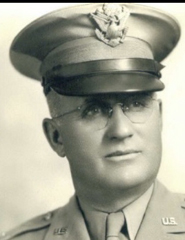MILES, CLARK GO ON TOUR
Iowan Bawled Out for Going in Mine Area
By Frank Miles (Iowa Daily Press War Correspondent)
Somewhere in the Mediterranean War Theater, Sept 4 -- (IDPA)
"How would you like to go on a tour with Lt. Gen. Mark Clark today?" the chief of public relations officer of the 5th army asked.
"Okay" he added, noting my expression. "Get yourself over to the airport at 9 o'clock."
I was there ahead of time. The tall, bronzed leader of American forces in the drive through Italy - a real "GI General" - greeted me cordially. He knew many Iowans, among them Lt. Gen Mat A. Tinely, of Council Bluffs, with whom he had been on maneuvers and whom he liked and admired greatly. Yes, and he had unbounded admiration for Iowa troops who and been and were in his command.
The general got into one Cub plane, I into another. We landed at a place where we were joined by Maj. Gen. John B. Coulter, commanding the 85th division, who liked Iowa from service as major in the 14th cavalry at Fort Des Moines in 1921. He is another "GI General".
The two generals and I got into a command car (glorified jeep). Driver was Sgt. Lewis Schmidt, of Holstein, Iowa, and quietly proud of it. He was a truck driver when he joined the army.
After a jaunt we stopped for General Clark to pin the Distinguished Service Cross on Pfc. Marvin Doolin, of Danville, Va. The few miles took us up a mountain on a curving, rain, bomb and traffic cut dirt road that would make most anything I ever saw at home look like a paved level highway. Doolin had come in from an outpost for the award. The citation read almost like one for a Congressional Medal of Honor. The boy had shown amazing courage but when he stood before Gen. Clark with a few of his buddies behind him sweat poured from his ruddy, grimy face and his knees actually knocked. He admitted later he was "scared pink."
During the day we were constantly in range of enemy artillery and for a while they could have caught us with machine guns. Of course Jerry didn't know it or we would have run into a real barrage. Both Generals Clark and Coulter have had many, many close calls.
We visited several outposts, all skillfully camouflaged. General Coulter's headquarters, where we had dinner, looked so like a thicket as to give excellent protection from hostile airplanes.
At one message center we could see the Germans through a BC scope which had been captured from them. An occasional plummet of dust in their area indicated allied gunners had their location.
There I came across Capt. Don Ogg of Davenport, a former Iowa State college student, who had a little girl he had seen and a little boy he hoped to soon. In his outfit was Sgt. Robert Glow, a personable young chap of Storm Lake, Iowa, who was inducted from Buena Vista county, May 21, 1942, and wanted nothing so much as to return there.
After finishing his schedule in that area Gen. Clark and I again got into our Cub planes and then flew to a town where a friend was in the hospital. Word of Clark's presence spread swiftly. When he emerged no fewer than a hundred American soldiers were assembled around to see him.
About half of them had cameras. When the general saw so many desired to "shoot" him he obligingly halted and stood still for a moment, shook hands with a startled GI near him, climbed into a car and we drove off again. Throughout the ground miles we traveled soldiers saluted their chief with smiles and he never failed to return one he saw.
At 5th army headquarters I visited with Pfc. Harry Bonnema, Jr., of Le Mars, who has a brother in the Pacific, and a brother, Gerald, in the merchant marine; Pfc. Harold Meyer of Wall Lake and Sgt. Bob Bowers of Fort Dodge; and Pfc. Arnold Vargason of Oelwein, a radio communications man. Vargason has a brother, Walter, whom he saw over here recently for the first time in 3 years.
I got bawled out by an MP that day for walking off a road into a field to see an abandoned nazi pill box. "Mines," the soldier warned. The Germans left thousands of hidden death dealing devices when they retreated. Some have been found, some will be a source of danger for years. One, if you step on it, springs up about 4 feet and shoots 325 pieces of steel.
Source: Mason City Globe-Gazette, September 16, 1944
![]()

